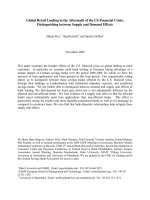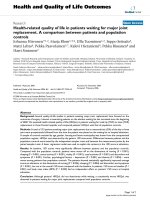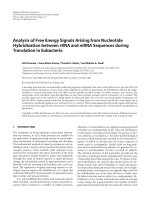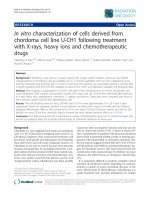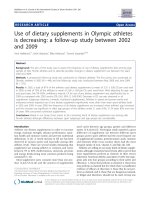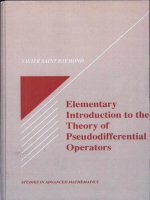Bruchid resistance studies in advanced stabilized F6 lines derived from interspecific hybridization between cowpea and rice bean
Bạn đang xem bản rút gọn của tài liệu. Xem và tải ngay bản đầy đủ của tài liệu tại đây (230.52 KB, 10 trang )
Int.J.Curr.Microbiol.App.Sci (2018) 7(9): 763-772
International Journal of Current Microbiology and Applied Sciences
ISSN: 2319-7706 Volume 7 Number 09 (2018)
Journal homepage:
Original Research Article
/>
Bruchid Resistance Studies in Advanced Stabilized F6 Lines Derived From
Interspecific Hybridization between Cowpea and Rice Bean
A.R. Vishwas* and S.K. Deshpande
Department of Genetics and Plant Breeding, UAS, Dharwad, Karnataka-580005, India
*Corresponding author
ABSTRACT
Keywords
Bruchid, Cowpea,
Resistance
Article Info
Accepted:
06 August 2018
Available Online:
10 September 2018
Cowpea [Vigna unguiculata (L.) Walp.] is an important tropical legume crop, its grain
contains about 25% protein and 64% carbohydrate, therefore, it is also called as a
vegetable meat. In storage, Callosobruchus maculatus, also called cowpea beetle, cowpea
weevil or bruchid, is regarded as the most important and common pest of cowpea both in
Africa and Asia. All vigna crops except rice bean are susceptible to bruchids. So in this
context in the present study the 100 stabilized families in F 6 generation of cross between
cowpea and rice bean were evaluated. The segregants F6 -229 and F6 -239 were identified
as a resistant to bruchids since these have a less bruchid infestation (%) with values of
8.5% and 12.5% respectively.
Introduction
Cowpea [Vigna unguiculata (L.) Walp.] is an
important tropical legume crop, its grain
contains about 25% protein and 64%
carbohydrate, therefore, has a tremendous
potential to contribute to the alleviation of
malnutrition among resource-poor farmers, so
it provides nutritious grain and an inexpensive
source of protein for both rural poor and urban
consumers. Meanwhile, it is more important as
the source of green as well as dry fodder.
Cowpea has the ability to do well even in the
drought conditions. However, cowpea
production is faced with a wide range of biotic
constraints like virus (Cowpea Aphid-Borne
Mosaic Virus, CABMV), Pest like bruchids,
aphids, pod borer etc. (Singh, 2005).
In storage, Callosobruchus maculatus, also
called cowpea beetle, cowpea weevil or
bruchid, is regarded as the most important and
common pest of cowpea both in Africa and
Asia (Jackai and Daoust, 1986; Deshpande et
al., 2011). This weevil has caused losses both
in quality and quantity of the stored seeds. An
estimate of storage losses of 90-100% is
evident (Umeozor, 2005). Due to perforations
by this weevil, thus reducing the degree of
usefulness and making the seeds unfit either
for planting or human consumption (Ali et al.,
2004). The control of this storage grain pest
carried out by chemical methods is not viable
since it cause harmful effect to human as well
as to the environment. In this regard
alternative methods could be the development
of the resistance varieties which are actually
economically viable, environmentally safe,
763
Int.J.Curr.Microbiol.App.Sci (2018) 7(9): 763-772
ecologically stable and long lasting (Lale et
al., 1996). Legume researchers have been
seeking for sources of bruchid resistance in
both cultivated and wild vigna species. The
sources of resistance in the primary gene pool
of cultivated cowpea is very limited. All vigna
crops except rice bean are susceptible to
bruchids. Rice bean is one crop under vigna
genus which is completely resistant to
bruchids. Hence, earlier Dr. S. K. Deshpande,
Cowpea breeder, University of Agricultural
sciences, Dharwad during the year 2014 had
attempted interspecific crosses between
Cowpea and Rice bean and advanced the
generations till F5. So in the present study an
attempt was made to evaluate 498 F5 families
under field condition for yield traits and based
on yield per se 100 best F6 families were
screened for bruchid resistance under artificial
infestation in laboratory.
muslin cloth secured by rubber band. The
artificial screening of the cowpea seeds
against bruchids was undertaken according to
the procedure followed by Basavaraj (2010).
Seeds of each progeny weighing 20 g were
kept in a plastic glass of 100 ml capacity, six
pairs of adults (males and females) were
introduced in each plastic glass and tops were
kept covered with muslin cloth and tightly
concealed by rubber bands. After seven days
adults were removed and were kept under
normal room temperature and humidity for a
period of 45 days. After the specified period
of 45 days each bottle was examined for loss
of weight in terms of actual weight loss and
apparent weight loss was determined.
Materials and Methods
U (Nd) – D (Nu)
Actual weight loss (%) = ----------------- 100
U (Nu + Nd)
The experiment was conducted during kharif
2017 at Botanical garden, Department of
Genetics and Plant Breeding, University of
Agricultural Sciences, Dharwad. The F5
population generated earlier between cross DC
615 (Susceptible to bruchids) × Rice bean
(Resistant to bruchids) was used for the
present study. About 498 F5 families were
selfed and advanced to F6 generation. Based
on yield per se top 100 F6 progenies were
selected and used in the present study. Two
checks of cowpea such as DC 15 (Moderately
resistant check) and DCS 47-1 (susceptible
check) and three rice bean checks (Dharwad
local and ricebean germplasms IC-524075 and
IC-341983) were also used.
Initial culture of Callosobruchus maculatus
was obtained from the infected grains of
cowpea from the farm stores. They were
reared and maintained on cowpea by releasing
ten pairs of adults (males and females) in stem
jars. The mouth of the jar was covered with
Actual weight loss was calculated by using the
following formula (Adams and Schulten,
1978).
Where;
(Nd) = Number of damaged seeds [seeds
showing emergent holes].
(Nu) = Number of undamaged seeds.
(D)= Weight of damaged seeds.
(U) = Weight of undamaged seeds.
(Nd + Nu) = Total number of seeds in 20 g.
Apparent weight loss was worked out using
the following formula (Girish et al., 1975).
Initial weight – Final weight
Apparent weight loss (%) = -------------- 100
Initial weight
In general,
Apparent weight loss (%) = Wi - Wn/ Wi 100
764
Int.J.Curr.Microbiol.App.Sci (2018) 7(9): 763-772
Where,
Wi = Initial weight of seeds at the beginning
experiment
Number of normal seedlings obtained
Germination (%) = ------------------------- 100
Total number of seeds put for germination
Wn = Weight of seeds after „n‟ days (45 days)
The moisture content of seeds was determined
by the oven dry (103 ± 1 °C for 17 ± 1 hours)
method as per ISTA rules. The moisture
content on wet basis was determined and
expressed in percentage using the following
formula.
M 2 – M3
Moisture content (%) = ------------- 100
M 2 – M1
From the germination test, ten random
seedlings from each of the genotype were
carefully used for measuring seedling length.
The seedling length from tip of shoot to tip of
root was measured and the average length of
the seedling was noted down. From the
germination percentage and seedling length,
Seedling vigor index was calculated by
following formula as per Abdulbaki and
Anderson (1973).
Where,
Seedling vigor index = Germination (%)
Seedling length (cm)
M1 – Weight of the empty metal box (g)
Results and Discussion
M2 – Weight of metal box with seed sample
before drying (g)
Based on per cent bruchid infestation the F6
segregants were classified as highly resistant,
moderately resistant, least susceptible,
moderately susceptible and highly susceptible,
as presented in the Table 1. As shown in Table
1, the per cent bruchid infestation varied much
among the different classes, the highly
resistant (HR) class recorded 12.50 per cent
bruchid infestation and moderately resistant
(MR), least susceptible (LS), moderately
susceptible (MS), highly susceptible (HS)
classes recorded 30.71 per cent, 50.45 per
cent, 68.40 per cent and 85.50 per cent
bruchid infestation respectively. Accordingly,
top 10 resistant F6 segregants are given in the
Table 2. The results revealed that, F6-229
segregant recorded least per cent bruchid
infestation (8.5 %) followed by F6-239 (12.5
%). Among the rice bean resistant checks,
Dharwad local, germplasm lines IC-524075
and IC-341983 recorded 0 per cent infestation,
the variety DC 15 exhibited infestation of
23.50 per cent and considered as moderately
resistant and DCS 47-1 reported 65.5 per cent
M3 – Weight of metal box with seed sample
after drying (g)
The percentage infestation was calculated by
using following formula
Number of seeds with emergent holes
Infestation (%) = --------------------------- 100
Total number of seeds observed
Based on per cent bruchid infestation, cowpea
genotypes were classified according to
Nagaraj (2006). The classification is as
follows.
Similarly germination percentage was also
worked out before and after infestation
according to paper towel germination test and
reduction in germination was calculated and
genotypes were compared based on these
results.
765
Int.J.Curr.Microbiol.App.Sci (2018) 7(9): 763-772
infestation,
regarded
as
moderately
susceptible. Since highly resistant have
considerable amount of protein ant nutritional
factors like saponins, phenols, Trypsin
inhibitors, chymotrypsin inhibitors lectins and
antifungal peptides or those are not favorable
for insect oviposotion and egg laying. These
factors contribute to the less bruchid
infestation in resistant genotypes. The seed
moisture content of different classes of F6
progenies are presented in Table 3. The highly
resistant (HR) class reported 6.53 per cent
moisture content. While, moderately resistant
(MR), least susceptible (LS), moderately
susceptible (MS) and highly susceptible (HS)
classes reported 7.54 per cent, 8.99 per cent,
13.75 per cent and 15.96 per cent moisture
content respectively, indicates the presence of
considerable variability among different
classes for seed moisture content. Similarly,
seed moisture (%) of top 10 resistant F5
progenies is presented in Table 4. The
progeny, F6-229 contained minimum moisture
(6.48 %) followed by F6-239 (6.55 %). Since
there is difference among different classes,
this clearly indicates that seed moisture
content of genotypes influence the resistance
or susceptibility against bruchids attack.
While, the moderately resistant check DC
15(MR) recorded 8.65 per cent moisture,
moderately susceptible check DCS 47-1 (MS)
recorded 10.08 per cent moisture. Highly
resistant rice bean checks Dharwad local, IC524075 and IC-341983 have 12.35, 14.25 and
11.44 per cent moisture respectively, so
mostly in these rice bean checks compared to
moisture content, seed size, hard seed coat and
other biochemical factors play an important
role in resistance. So less moisture is
associated with the resistant nature of the
cowpea seeds.
The results pertaining to the per cent actual
weight loss in different groups of F6 lines after
infestation are presented in Table 5. There was
a variability existed among the different F6
lines. The highly resistant (HR) group showed
3.58 per cent actual weight loss, while
moderately resistant (MR), least susceptible
(LS), moderately susceptible (MS) and highly
susceptible (HS) groups showed 7.26 per cent,
11.97 per cent, 16.93 per cent and 22.35 per
cent actual weight loss respectively. The
actual weight loss (%) of top 10 resistant lines
out of 100 F6 lines is given in Table 6. The
results showed that the progenies F6-229 and
F6-239 recorded least actual weight loss of
3.25 and 3.20 per cent respectively. Among
the checks IC-341983 exhibited minimum
weight loss (0.11 %), while IC-524075,
Dharwad local, DCS 47-1 and DC 15
exhibited 0.744 per cent, 0.725 per cent, 6.54
per cent, and 5.36 per cent actual weight loss
respectively. The minimum actual weight loss
is attributed to minimum adult emergence and
less seed damage. Lambrides and Imrie (2000)
reported that the tolerant varieties showed the
least weight loss against bruchids, which
could be attributed to the small size, seed coat
thickness, seed coat width and presence of
well-formed texture layer on the seed. In
Table 5 results indicates the apparent weight
loss (%) of different classes of F6 families due
to infestation at 45 days after release of
bruchids was minimum in the highly resistant
(HR) class with 5.43 per cent apparent weight
loss, while moderately resistant (MR), least
susceptible (LS), moderately susceptible (MS)
and highly susceptible (HS) classes reported
8.86 per cent, 13.18 per cent, 18.36 per cent
and 23.82 per cent apparent weight loss
respectively. Among top 10 resistant lines
mentioned in Table 6 the segregant F6- 229
have less apparent weight loss with 4.9 per
cent where it has values 6.4, and 7.3, in
moderately resistant and susceptible checks
such as DC15, DC S47-1, and 2.75, 2.3 and
2.2 percent in resistant checks of ricebean
namely IC-524075, IC-341983 and Dharwad
local respectively. These results are in
agreement with findings of Divya et al.,
(2012) who stated that entries which were
766
Int.J.Curr.Microbiol.App.Sci (2018) 7(9): 763-772
least favored by bruchids for oviposition, adult
emergence and insect recorded less percent
weight loss are resistant to bruchids.
The results pertaining to number of adults
emerged out of different classes of stabilized
F6 lines are depicted in Table 5. High degree
of variation was observed among the different
stabilized F5 lines. The highly resistant (HR)
class reported 12.16 number of bruchids
emerged, while moderately resistant (MR),
least susceptible (LS), moderately susceptible
(MS) and highly susceptible (HS) classes
reported 31.81, 52.93, 73.82 and 95 number of
bruchids emerged respectively. Considerably
least number of bruchids were emerged in F6
lines namely, F6-229 and F6-239 exhibited
number of bruchids with 11 and 12 adults
respectively (Table 6). As far as checks are
concerned, checks Dharwad local, IC-524075
and IC-341983 have 0 number of bruchids
adult emergence whereas, DC 15 and DCS 471 showed 35 and 105 adults respectively after
45 days of infestation. The reason for
resistance may be due to oviposition and
antibiosis to egg and larva. Adult recovery is
hampered by unpalatable physicochemical
characteristics of grains. The seed germination
(%) at initial and 45 days after release of
bruchids was recorded (Table 7). The results
shows that the minimum reduction in
germination percentage was seen in highly
resistant class with 2.46% and it was followed
by moderately resistant (MR), least
susceptible (LS), moderately susceptible (MS)
and highly susceptible (HS) classes reported
4.35, 6.33, 9.05 and 13.19 per cent reduction
respectively. While among top 10 resistant
lines (Table 8), F6- 229 have least reduction in
germination per centage with value of 2.35
and among checks lowest reduction was
observed for check IC-341983 (1.09%) and it
was followed by IC-524075, Dharwad local,
DC 15 and DCS 47-1 with values 1.10, 2.2,
6.59 and 16.67 respectively.
Based on per cent bruchid infestation, cowpea genotypes were classified according to
Nagaraj (2006)
Class
Highly resistant
Moderately resistant
Least susceptible
Moderately susceptible
Highly susceptible
Bruchid infestation (%)
00-20
21-40
41-60
61-80
81-100
Table.1 Classification of F6 Segregants in terms of resistance to bruchid based on mean percent
bruchid infestation at 45 days after infestation
Class
Range
Average infestation
No of segregants
Highly resistant
Moderately resistant
Least susceptible
Moderately Susceptible
Highly Susceptible
0-20
21-40
41-60
61-80
81-100
12.50
30.71
50.45
68.40
85.50
3
36
37
20
4
767
Int.J.Curr.Microbiol.App.Sci (2018) 7(9): 763-772
Table.2 Bruchid infestation among the top 10 resistant and stabilized F6 lines derived from
Cowpea x Rice bean crosses
Sl. No.
Segregants
% bruchid infestation
1
F6-229
8.5
2
F6-239
12.5
3
F6-127
16.5
4
F6-226
20.5
5
F6-224
21
6
F6-85
23
7
F6-44
23.5
8
F6-222
25
9
F6-193
25.5
10
F6-226
25.5
Checks
1
DC15 (Cowpea variety)
23.5
2
DCS 47-1 (Cowpea variety)
65.5
3
IC-524075
(Rice bean germplasm accession)
IC-341983
(Rice bean germplasm accession)
Dharwad local
(Local Rice bean genotype)
0
4
5
0
0
DC 15– Cowpea variety moderately resistant check
DC47-1 – Susceptible check
IC-524075- Ricebean germplasm, resistant check
IC- 341983- Ricebean germplasm, resistant check
Dharwad local- Local Rice bean genotype, resistant check
Table.3 Mean seed moisture (%) among the different bruchid resistant classes
Class
No of segregants
Seed moisture (%)
Highly resistant
3
6.53
Moderately resistant
36
7.54
Least susceptible
37
8.99
Moderately Susceptible
20
13.75
Highly Susceptible
4
15.96
768
Int.J.Curr.Microbiol.App.Sci (2018) 7(9): 763-772
Table.4 Seed moisture content among top 10 resistant F6 segregants
Sl. No.
Segregants
Seed moisture (%)
1
F6-229
6.48
2
F6-239
6.55
3
F6-127
6.59
4
F6-226
6.66
5
F6-224
6.81
6
F6-85
6.84
7
F6-44
6.88
8
F6-222
6.99
9
F6-193
6.99
10
F6-226
7.10
Checks
1
DC15 (Cowpea variety)
8.65
2
DCS 47-1(Cowpea variety)
10.08
3
IC-524075 (Rice bean germplasm
accession)
IC-341983 Rice bean germplasm
accession)
Dharwad local (Local Rice bean
genotype)
14.25
4
5
11.44
12.35
Table.5 Mean actual weight loss, apparent weight loss, number of bruchids emerged among
bruchid resistance classes F6 segregants
Class
No of
segregants
Actual loss
(%)
Apparent loss
(%)
No of bruchid
emrged
Highly resistant
3
3.58
5.43
12.16
Moderately
resistant
Least susceptible
36
7.26
8.86
31.81
37
11.97
13.18
52.93
Moderately
Susceptible
Highly Susceptible
20
16.93
18.36
73.82
4
22.35
23.82
95.5
769
Int.J.Curr.Microbiol.App.Sci (2018) 7(9): 763-772
Table.6 Actual weight loss, apparent weight loss, number of bruchids emerged among top 10
bruchid resistance classes of F6 segregants
Sl.
No.
1
2
3
4
5
6
7
8
9
10
Segregants
1
2
3
DC15 (Cowpea variety)
DCS 47-1(Cowpea variety)
IC-524075
(Rice
bean
germplasm accession)
IC-341983 Rice bean
germplasm accession)
Dharwad local (Local Rice
bean genotype)
4
5
F6-229
F6-239
F6-127
F6-226
F6-224
F6-85
F6-44
F6-222
F6-193
F6-226
Actual loss
(%)
3.25
3.25
4.25
4.56
5.21
5.25
5.25
5.58
5.58
5.58
Checks
5.36
6.54
0.744
Apparent loss
(%)
4.9
5.1
6.3
6.7
6.75
6.75
6.75
7.2
7.3
7.3
No of bruchid
emrged
11
12
13.5
18
20
22
22
26.5
27
27
6.4
7.3
2.75
35
105
0
0.11
2.3
0
0.725
2.2
0
This reduction in the seed germination is due
to reduction in seed viability due to increased
seed damage and bruchid infestation. (Tomaz
et al., 2007) found in some cases larval
feeding effectively kills the embryo or feeds
on the endosperm so that that the seed cannot
be germinated. Sometimes larval feeding
create opening for pathogenic bacteria and
fungi (Chang et al., 2011).
Among checks, Dharwad local, recorded
minimum reduction in seedling length (3.15
%) while checks, IC-341983, IC-524075, DC
15 and DCS 47-1 shows 3.48, 4.72, 6.82, and
8.03 per cent reduction in seedling length
respectively. The reduction in seedling length
in highly susceptible plants is may be
attributed to the depletion of cotyledon
reserves due to the larval feeding of bruchid
which later leads to the slower and reduced
growth of the plants.
The results on percent reduction in seedling
length (Table 7) revealed that reduction is
maximum in highly susceptible class with
17.68 percent and it is followed with
moderately susceptible, least susceptible,
moderately resistant and highly resistant class
with 12.03, 9.17, 6.62, and 3.79 per cent
respectively. Among top 10 resistant lines
(Table 8), the lowest percent reduction was
for the segregant F6-229 followed by F6-239.
The results pertaining to seedling vigor index
is shown in table 7. In case of highly resistant
varieties the reduction in seedling vigor index
was less with value of 6.16 per cent compared
to moderately resistant, least susceptible,
moderately susceptible and highly susceptible
types with values of 10.67, 14.92, 19.98 and
28.52 percent reduction respectively. Among
770
Int.J.Curr.Microbiol.App.Sci (2018) 7(9): 763-772
top 10 resistant F6 stabilized lines (Table 8),
F6- 229 registered less reduction in seedling
vigor index with the value of 5.63% and it
was followed by F6- 239 with 6.17%. Among
the checks, the seedling vigor index was more
reduced in check DCS 47-1 with 21.69 % and
it was followed by DC15, IC524075,
IC341983 and Dharwad local with 12.97,
6.78, 4.50 and 6.3 percents reduction
respectively. The reduction in seedling vigor
index is mainly attributed to lowest value in
seedling germination % and less seedling
length in susceptible varieties since vigor is
calculated by using both parameters.
Unguiculata L. Walp) for yield and
disease resistance. Int. J. Environ. Sci.
Technol., 1: 119-123.
Basavaraj,
M.,
2010,
Phenotypic
characterization, assessment of genetic
diversity, screening for protein content
and bruchid infestation in cowpea
[Vigna unguiculata (L.) Walp.]
genotypes. M. Sc. (Agri.) Thesis, Univ.
Agric. Sci., Dharwad, Karnataka
(India).
Chang, S. m., Gonzalez, E., Pardini, E. and
Hamrick, J. L., 2011, Encounters of old
foes on a new battle ground for an
invasive tree, Albizia Julibrissin
Durazz. Biol. Invasions., 13 (4): 10431053.
Deshpande, V.K., Makanur, B., Deshpande,
S.K., Adiger, S., & Salimath, P.M.
(2011), and “Quantitative Qualitative
losses caused by Callosobruchus
maculates in Cowpea during Seed
Storage”, Plant Archives 11(2), 723731.
Divya, P., Kanaka Durga, K., Sunil, N.,
Rajasri, M. and Udayababu, P., 2012,
Screening of horse gram accessions
against pulse beetle, Callosobruchus
chinensis. Indian J. Pl. Prot., 40 (4):
280-286.
Girish, G. K., Jain, S. K., Ashok, K. and
Agrawal, N. S., 1975, Assessment of
storage losses quality and particular
concentration in wheat availability in
the market of western UP, Punjab and
Haryana. Bull. Grain Technol., 13: 818.
Jackai, L.E.N. & Daoust, R.A. (1986), “Insect
pests of cowpea”, Annual Review of
Entomology 31, 95-119.
Lambrides, C. j. and Imrie, B. c., 2000,
Susceptibility of mungbean varities to
the bruchid species Callosobruchus
maculatus, C. analis, C. chinensis and
Canthoscelides obtectus. Australian J.
Agric. Res., 51: 85-89.
So from this study we have identified the
some of the stabilized F6 lines such as F6229, F6 - 239 of interspecific cross between
cowpea × ricebean to exhibit enhanced level
of resistance to bruchids along with desirable
seed characters. These stabilized F6
segregants further will be evaluated for
biochemical and artificial bruchid infestation
studies and desirable transgressive segregants
for bruchid resistance and favorable seed
characteristics will be identified in future
studies. Such new stabilized lines hold
promise will be used to develop new bruchid
resistant high yielding cowpea varieties or as
parents in cowpea hybridization programs.
References
Abdulbaki, A. A. and Anderson, J. D., 1973,
Vigour determination in soybean by
multiple criteria. Crop Sci., 13: 630633.
Adams, J. M. and Schulten, G. M., 1978,
Losses caused by insects, mites and
micro-organisms in post-harvest grain
loss assessment methods. American
Assoc. Cereal Chemist. St. Paul
Minnesota, USA, p. 193.
Ali, Y., Aslam, Z., Hussain, F. and Shakur,
A., 2004, Genotype and environmental
interaction
in
cowpea
(Vigna
771
Int.J.Curr.Microbiol.App.Sci (2018) 7(9): 763-772
Nagaraja, M., 2006, Evaluation of pigeon pea
and cowpea genotypes for bruchid
resistance. M. Sc. (Agri.) Thesis, Univ.
Agric. Sci., Dharwad, Karnataka
(India).
Singh, B.B. (2005), “Cowpea (Vigna
unguiculata (L.) Walp.)”, In: Singh,
R.J. & Jauhar, P.P. (Eds), Genetic
resources, chromosome engineering and
crop improvement. Vol 1. CRC Press,
Boca Raton, FL, USA, 117-162.
Tomaz, C.A., Kestring, D. and Rossi, M. N.,
2007, Effects of the seed predator
Acanthosceelides
schrankitae
on
viability of its host plant Mimosa
bimucronata. Bio. Res., 40(3): 281-290.
Umeozor, O.C. (2005), “Effect of the
infection of Callosobruchus maculatus
(Fab.) on the weight loss of stored
cowpea (Vigna unguiculata (L.)
Walp)”, Journal of Applied Science and
Environmental Management 9(1), 169172.
How to cite this article:
Vishwas, A.R. and Deshpande, S.K. 2018. Bruchid Resistance Studies in Advanced Stabilized
F6 Lines Derived From Interspecific Hybridization between Cowpea and Rice Bean.
Int.J.Curr.Microbiol.App.Sci. 7(09): 763-772. doi: />
772
